Tektronix MSO3000 Mixed Signal Oscilloscope Series up to 500 MHz
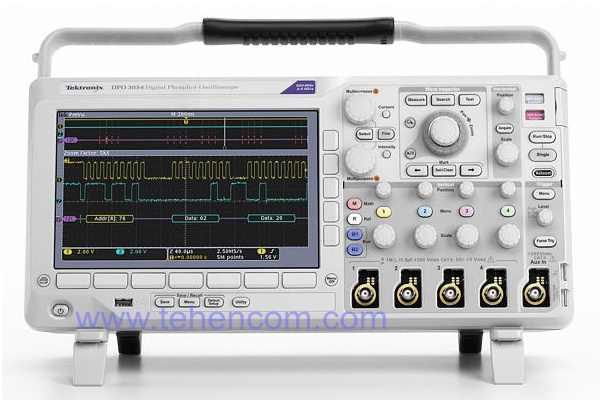
Product code: 1000789
Add item to cart. Our specialist will coordinate with you the complete set, tell you the price and delivery time.
Price on request
Out of production. Recommended replacement: Tektronix MDO3
SHORT DESCRIPTION
Oscilloscope Series MSO3000 American company Tektronix have a bandwidth of up to 500 MHz and a sampling rate of 2.5 GS/s, and also provide very wide functionality for debugging various types of devices.
Through the use of digital phosphor technology (post-glow effect) to quickly visualize signal anomalies, panels Wave Inspector With ease of navigation and automatic analysis of serial buses and power supplies, Tektronix's MSO3000 Series oscilloscopes offer the advanced tools you need to simplify and speed up debugging complex circuits.
Areas of use:
- research and debugging of embedded systems
- debugging of serial interfaces
- debugging of systems with mixed signals (MSO)
- development of automotive electronics
- development of video systems
- power measurements
Tektronix MSO3000 Series Key Features:
100 MHz, 2.5 GS/s, 2 channels + 16 digital channels (Tektronix MSO3012 model).
100 MHz, 2.5 GS/s, 4 channels + 16 digital channels (Tektronix MSO3014 model).
300 MHz, 2.5 GS/s, 2 channels + 16 digital channels (Tektronix MSO3032 model).
300 MHz, 2.5 GS/s, 4 channels + 16 digital channels (Tektronix MSO3034 model).
500 MHz, 2.5 GS/s, 4 channels + 16 digital channels (Tektronix MSO3054 model).
Record length:
5 million points to the channel.
Vertical resolution: 8 pages (11 bits in high resolution mode).
Sensitivity: 1 mV/div to 10 V/div with a calibrated setting.
Continuous waveform capture rate: up to 50,000 waveforms/s.
29 automatic measurements, FFT analysis (FFT), mathematical signal processing, cursor measurements, mask measurement, context help, Russian interface.
Interfaces: USB, Ethernet and VGA. Weight: 4.2 kg.
Out of production. Recommended replacement: Tektronix MDO3.
Need an oscilloscope faster and cheaper? Watch the series Tektronix MSO/DPO2000.
Need more functions and features? Watch the series Tektronix MDO3000.
Need galvanized isolated channels? Watch the series Tektronix TPS2000B.
Difficult to decide on a model? See helper: How to choose an oscilloscope.
DETAILED DESCRIPTION
The MSO3000 Series oscilloscopes can visualize analog, parallel, and serial digital waveforms, allowing you to quickly find problems in complex embedded systems. Bandwidth up to 500 MHz and 5x oversampling on all channels provide the performance needed for many of today's applications. All channels provide a record length of up to 5M points in standard configuration, allowing you to capture long signal fragments while maintaining high time resolution.
The MSO3000 Series oscilloscopes offer a wide range of features that speed up all stages of debugging, from fast anomaly detection and capture to finding events in recorded waveforms, analyzing their characteristics and the behavior of your device.
Detection and capture
In order to fix the problem, you need to localize it. Every design engineer has to spend time finding problems in the device being developed, which, in the absence of the necessary tools, turns into a very tedious and time-consuming process.
The MSO3000 Series oscilloscopes offer the most comprehensive set of visualization features in their class, allowing you to gain a deeper understanding of the true processes occurring in your device. The high acquisition rate of over 50,000 waveforms per second allows you to spot glitches and other short-term processes in seconds, revealing the true nature of the failures that occur. The digital phosphor display shows the history of signal activity by coloring those areas of the screen where the signal occurs more often in brighter colors, which allows you to visually assess the frequency of occurrence of anomalies.
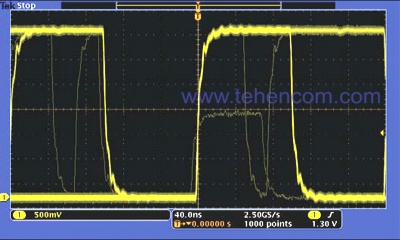
Detection: Fast waveform capture rate of over 50,000 waveforms per second maximizes the chance of detecting transient glitches and other infrequent events |
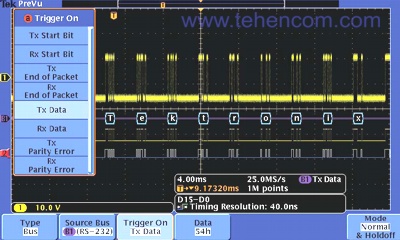
Capture: Trigger on a specific data packet transmitted over the RS-232 bus. Full set of triggering features, including triggering on the contents of a serial data packet, allows you to quickly capture the event of interest |
Finding device faults is just the first step. Now you need to capture the event of interest so that you can determine the cause of its occurrence.
To do this, the MSO3000 Series oscilloscopes offer a complete set of triggers, including bad pulse, logic, pulse width, setup/hold violation, serial burst, and parallel data, to help you quickly locate the event of interest. With a record length of up to 5M points, you can capture multiple events of interest and even thousands of consecutive packets at once, while maintaining high resolution, allowing you to see the smallest details of the signal in detail.
From triggering on the contents of a specific packet to automatically decoding various data formats, the MSO3000 Series oscilloscopes offer the widest range of serial buses in their class - I2C, SPI, CAN, LIN, RS-232/422/485/UART and I2S/ LJ/RJ/TDM. The ability to simultaneously decode up to two serial and/or parallel buses allows you to quickly identify system-level problems.
For deeper diagnostics of system-level interactions in complex embedded systems, the MSO3000 Series oscilloscopes have 16 digital channels in addition to analog. Because these digital channels are fully integrated into the scope's circuitry, you can trigger on any input channel, automatically timing all analog, digital, and serial signals. MagniVu's fast capture mode captures the finest signal details around the trigger point (up to 121.2 ps resolution). The MagniVu mode is particularly useful for precise timing, which is essential for measuring setup and hold times, clock latency, phase shifts, and glitch characteristics.
Essential troubleshooting and signal analysis tools
Without the proper tools, searching for an event of interest in a long signal record can be a very time consuming process. Given that a record can be over a million points long, searching for an event can mean scrolling through thousands of waveform screens.
The MSO3000 Series oscilloscopes offer the industry's most advanced search and navigation tools in an innovative control panel Wave Inspector. This panel speeds up the panning and stretching of fragments of the record. Thanks to the unique feedback system, you can move from one end of the recording to the other in a matter of seconds. Special markers allow you to mark any place where you want to return in the future. You can also perform automatic searches based on specified criteria. Wave Inspector instantly views the entire recording, including analog, digital and serial data. Along the way, it automatically marks all occurrences of the specified event and allows you to quickly move between them.
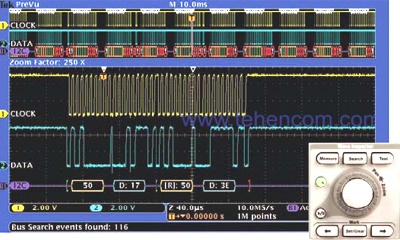
Search: I2C bus decoding function showing address 50 search results. Wave Inspector control panel provides unsurpassed browsing and navigation efficiency |
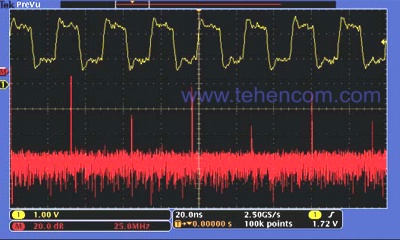
Analysis: fast Fourier transform of impulse signals. Comprehensive set of built-in analysis tools speed up circuit performance verification |
In order to check the compliance of the technical characteristics of the prototype with its software model and make sure that it is able to solve the tasks assigned to it, it is necessary to analyze all modes of operation of the prototype. This task can require a wide variety of measurements, from simple edge and pulse width tests to sophisticated power attenuation analysis and noise source investigations.
The MSO3000 Series oscilloscopes offer a comprehensive set of built-in analysis tools, including waveform and screen-based cursors, 29 automatic measurements, advanced math features including an equation editor, Fast Fourier Transform, and trend charts to visually determine how results change over time. Special programs for serial bus analysis, power supply design, and video design are also available.
For advanced analysis, you can use National Instruments' LabVIEW SignalExpress Tektronix Edition software, which offers over 200 built-in functions, including frequency and time domain analysis, boundary value checking, data logging, and custom reporting.
Navigation and search system Wave Inspector
A 5 million point record represents thousands of screens of information. Thanks to the control panel Wave Inspector - the industry's best navigation and search tool - the MSO3000 Series oscilloscopes give you the ability to find the events you need in seconds. The Wave Inspector control panel provides unsurpassed efficiency in viewing, navigating and analyzing data. By turning the outer panning knob, you can quickly view the entire 5M-dot recording (1). Moving from start to finish will take a matter of seconds. What if you see something interesting and want to take a closer look at it? Just turn the internal zoom knob (2):
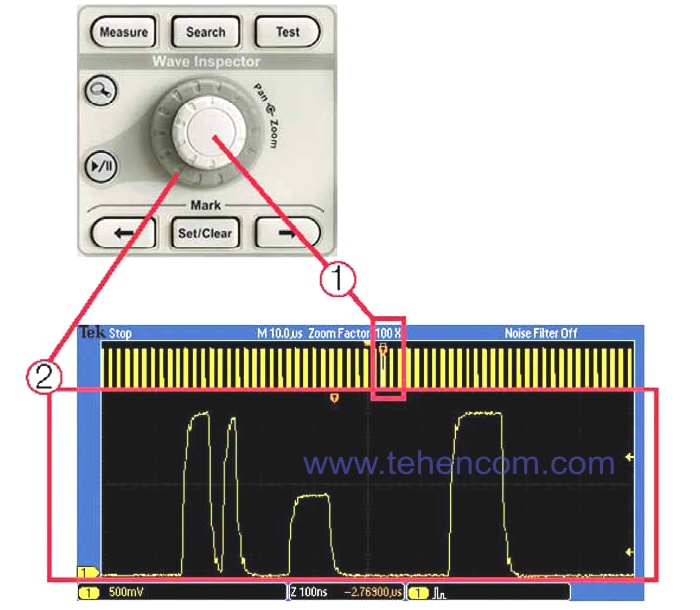
Wave Inspector includes the following innovative features:
Zoom/Pan (Zoom/Pan)
A dedicated two-level "Zoom/Pan" rotary knob on the front panel provides intuitive zoom and pan control. An internal "Zoom" knob allows you to adjust the stretch factor (or zoom). Turning it clockwise enables the signal to be stretched with a further gradual increase in the scaling factor. Turning the knob counterclockwise causes the stretch ratio to gradually decrease and eventually disables the zoom. Thus, it is no longer necessary to use multiple menus to adjust the image scale. Using the external Pan knob, you can move the view window around the waveform, which allows you to quickly get to the desired signal fragment. In addition, the external knob is equipped with a feedback mechanism that allows you to control the panning speed of the waveform in proportion to the angle of rotation. The more you turn the outer knob, the faster the viewport moves. The panning direction is changed by simply turning the knob to the other side.
Play/Pause (Play/Pause)
A dedicated front-panel "Play/Pause" button allows you to automatically scroll through the waveform on the oscilloscope screen while searching for anomalies and other events of interest to the user. The playback speed and direction are controlled by the pan control. As with panning, increasing the angle of the knob moves the waveform faster, and turning the knob the other way changes the direction of scrolling.
Custom labels
To mark one or more points of interest on the waveform, press the "Set Mark" button on the front panel. Moving between labels is carried out using the adjacent buttons " " ("Forward").
Search marks
The "Search" button allows you to automatically browse long waveform records to search for user-defined events. All found events are marked on the oscillogram with search marks, between which you can easily navigate using the " " ("Forward") buttons. The following can be used as search criteria: front, pulse/glitch duration, degenerate pulse (runt), logical state, setup and hold time violation, rise/fall time of the signal edge in the parallel bus, as well as the contents of the I2C, SPI, CAN bus packets, LIN, RS-232/422/485/UART and I2S/LJ/RJ/TDM.
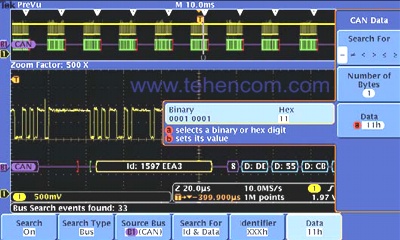
The first stage of the search: |
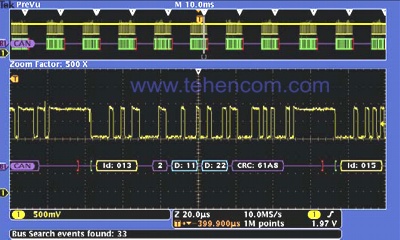
The second stage of the search: Wave Inspector automatically scans the record and marks the found events. You can now move between events using the back and forward arrow buttons |
Digital Phosphor Technology
The digital phosphor technology used in the MSO3000 Series oscilloscopes allows you to quickly evaluate the actual behavior of the device under test. High acquisition rates of over 50,000 waveforms per second provide a high probability of detecting transient problems common in digital systems: broken pulses, glitches, timing issues, and more.
The waveforms are superimposed on each other, and those waveform points that appear more often are painted in a brighter color. Due to this, frequently recurring events or, in the case of non-periodic anomalies, rarely occurring events are immediately highlighted.
The MSO3000 Series oscilloscopes allow you to set an infinite or variable hold time, which determines how long captured waveforms remain on the screen. This allows you to determine how often this or that anomaly occurs.

Digital phosphor technology in MSO3000 oscilloscopes provides
50,000 waveforms per second acquisition rate and real-time display of waveforms with brightness gradation
Design and Analysis of Mixed Signal Devices (MSO Series)
The MSO3000 series mixed signal oscilloscopes have 16 digital channels. These channels are seamlessly integrated into the oscilloscope's user interface, simplifying operation and making it easy to troubleshoot mixed-signal applications.
Waveform color coding
The MSO3000 Series oscilloscopes provide a new way to look at digital signals. All logic analyzers and mixed signal oscilloscopes have one common problem - the inability to distinguish zeros from ones when choosing a sweep mode in which the digital signal waveform is a single solid horizontal line. The MSO3000 Series oscilloscopes support color coding of digital waveforms with green 1s and blue 0s.
The MSO3000 Series simplifies the channel setup process by allowing digital waveforms to be grouped and labeled using a USB keyboard. Signals can be combined into a group by simply placing them next to each other on the screen. When a group is formed, all channels in the group can be moved at the same time. This greatly reduces the set-up time associated with the individual movement of each channel.
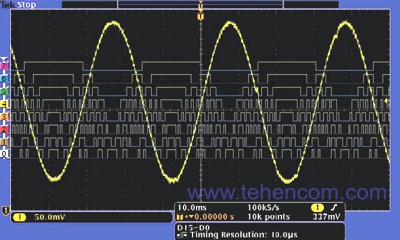
The MSO series has 16 digital channels for viewing and analyzing time-related analog and digital signals. |
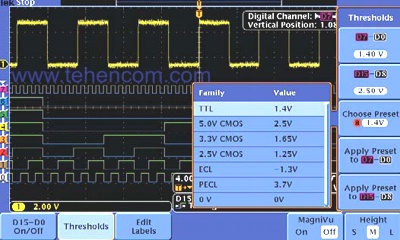
The color coding of digital signals allows them to be combined into groups by simply placing them next to each other on the screen. The tagged digital channels can then be moved as a group. Separate thresholds can be set for each group of eight channels to support two different types of LUNs |
The MSO3000 Series oscilloscopes' built-in multi-transition detection circuitry turns the signal edge white when multiple transitions are detected at that point. White edges indicate that stretching the signal or capturing it at a higher sampling rate can provide additional information. In most cases, stretching can show pulses that were not noticeable at the previous settings. If white edges persist even after maximum stretch, then upsampling on the next capture may reveal high-frequency information that was not available at the previous settings.
The MSO3000 Series oscilloscopes' main digital capture mode allows you to capture up to 5M points at 500MSa/s (with 2ns resolution). But in addition to the main mode, MSO3000 oscilloscopes offer an ultra-fast recording mode called MagniVu, which allows you to capture 10,000 points at up to 8.25 GS/s (with a resolution of 121.2 ps). Both main and MagniVu waveforms are captured on every trigger, and you can switch between them and display them in freeze or live sweep mode. MagniVu delivers significantly better timing resolution than comparable oscilloscopes on the market, inspiring confidence when making accurate timing measurements on digital signals.
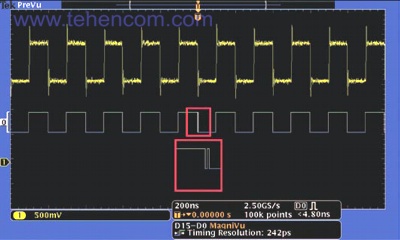
White fronts mean that image stretching can provide additional information. |
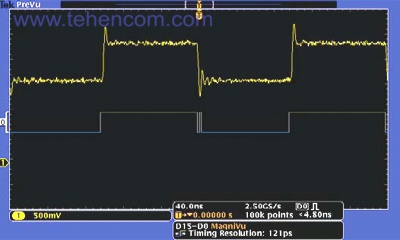
MagniVu Fast Acquisition mode provides 121.2 ps time resolution for accurate timing measurements on digital signals |
P6316 Mixed Signal Oscilloscope Probe
This unique probe has two groups of eight channels, making it easy to connect to your device under test. The P6316 probe can be directly connected to 16-pin (8*2) 2.54 mm pitch male headers located on printed circuit boards. In addition, if you need to connect to surface mount components or test points, you can use the supplied pigtail and clamp kit. The P6316 probe has excellent electrical performance with an input capacitance of only 8 pF and an input impedance of 101 kΩ.
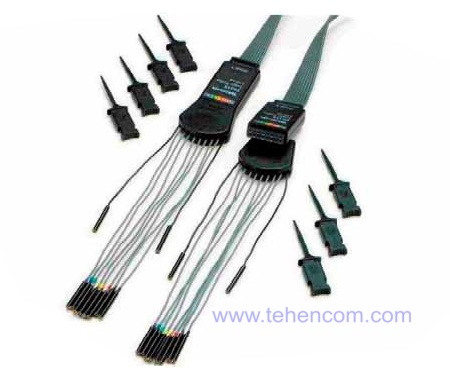
Serial triggering and analysis (optional)
A serial bus signal typically contains an address, control information, data, and a clock frequency, making it difficult to interpret the image on the oscilloscope screen and isolate events of interest. The MSO3000 Series oscilloscopes offer a convenient set of debugging tools for serial buses such as I2C, SPI, CAN, LIN, RS-232/422/485/UART, and I2S/LJ/RJ/TDM.
Serial Trigger
The MSO3000 Series oscilloscopes support triggering on packet contents such as start of packet, specific addresses or data, unique identifiers, etc. on popular serial interfaces such as I2C, SPI, CAN, LIN, RS-232/422/ 485/UART and I2S/LJ/RJ/TDM.
Bus representation
The high-level combined representation of the individual components of the bus signal (clock, data, chip select, etc.) makes it easy to find the beginning and end of packets and identify their components, such as address, data, identifier, checksum, etc.
Bus signal decoding
Tired of constantly searching for clock frequencies, zeros and ones? Tired of concatenating bits into bytes and calculating hexadecimal values? So entrust this work to the oscilloscope! Once you define a bus, the MSO3000 Series oscilloscopes will decode each packet on that bus and display its value in hex, binary, decimal (LIN only), signed decimal (I2S/LJ/RJ/TDM only), or ASCII (RS only). -232/422/485/UART) video.
Event table
In addition to displaying the decoded data on the waveform itself, it is possible to present all captured packets in tabular form, similar to how they appear in the program listing. In this case, the packets are time-stamped and divided into columns for each individual component (address, data, etc.).
Search
Serial triggering is very useful for highlighting events of interest. But if you have captured such an event and want to analyze it, what should you do next? Previously, in search of the cause of an event, the user had to manually scroll through the waveforms, read and convert bits. The MSO3000 Series oscilloscopes allow you to automatically view captured data and search by user-defined criteria, including the contents of serial data packets. Each detected event is marked with a search flag. To move quickly between labels, use the buttons " " ("Forward") located on the front panel.

Triggering from a specific data packet passing through the I2C bus. The yellow waveform is the clock signal and the blue waveform is the data. The bus waveform shows the decoded contents of the packet, including Start, Address, Read/Write, Data, and Stop |
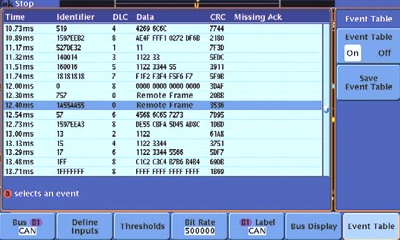
The event table displays decoded: identifier, DLC, data and checksum (CRC) for each CAN bus packet in long-term measurement |
Power supply analysis (optional)
The ever-increasing demand for extended battery life and the search for greener, lower power solutions require power supply designers to measure and minimize switching losses. In addition, to meet the requirements of international and national standards for power systems, it is necessary to measure the voltage of power supplies, the purity of the output spectrum and the level of harmonics in power circuits. Historically, measuring these and many other parameters with an oscilloscope has been a time consuming and painstaking manual process. The optional power supply analysis tools on the MSO3000 Series oscilloscopes make this task much easier, allowing you to quickly and accurately measure power quality, switching loss, harmonics, zone of stable operation (SOA), modulation, ripple and slew rate of current and voltage (dI/dt, dV/dt). Fully integrated into the oscilloscope circuitry, power analysis tools allow you to perform automatic, reproducible measurements at the touch of a button without an external computer or complex software setup.
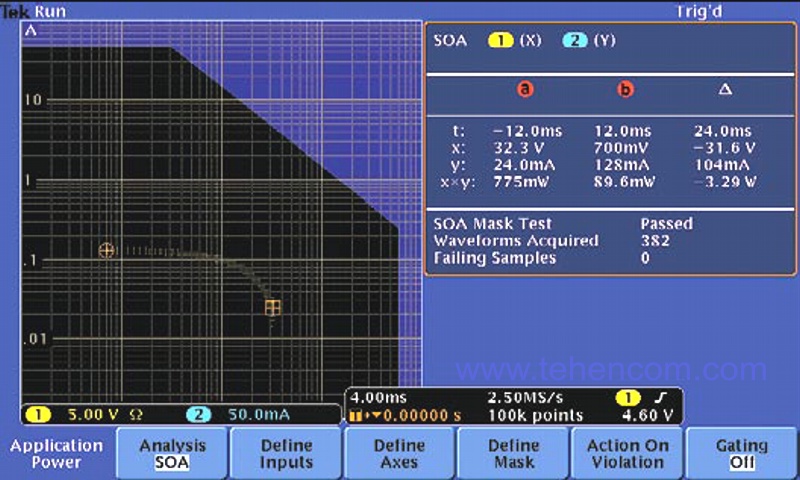
Design and development of video devices
Many video engineers remain devoted to analog oscilloscopes, believing that the brightness gradations on a CRT display are the only way to notice some of the fine details in a video signal. The high acquisition speed of the MSO3000 Series oscilloscopes, combined with signal brightness gradations, provides the same informative image as an analog oscilloscope, while at the same time allowing you to see much more detail and take full advantage of digital oscilloscopes.
Standard features such as IRE and mV scaling, field alignment, video polarity, and auto-tuning smart enough to detect video signals make the MSO3000 Series the easiest-to-use oscilloscopes for video applications. And with 500 MHz bandwidth, four analog inputs, and a built-in 75 ohm input terminator, the MSO3000 Series oscilloscopes are capable of handling both analog and digital video signals.
In addition, the video functionality of the MSO3000 Series oscilloscopes is complemented by the DPO3VID video processing software module. The DPO3VID module offers the most comprehensive set of HDTV triggering and special (non-standard) video triggering in its class.
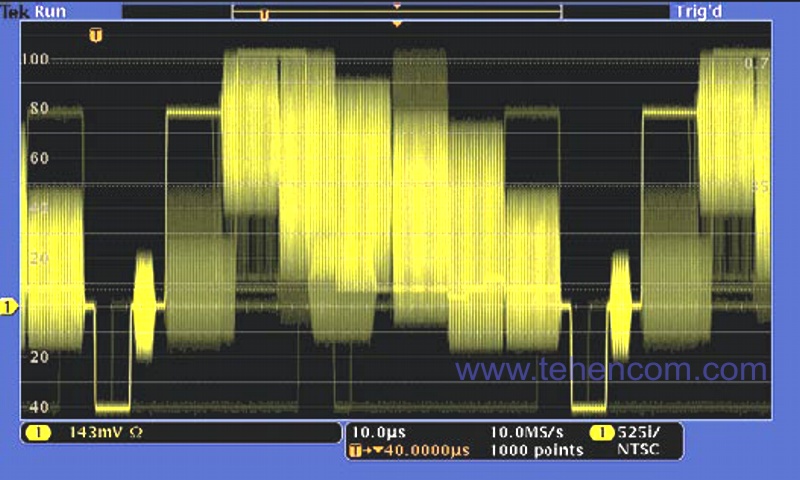
Advanced analysis tools
The MSO3000 Series oscilloscopes can display data and measurements by simply connecting the oscilloscope to a computer with a USB cable. All Required Software - NI LabVIEW SignalExpress™ Tektronix Edition LE, OpenChoice Desktop and Microsoft Excel and Word toolbars are standard and provide quick and easy interaction with a Windows PC.
NI LabVIEW SignalExpress Tektronix Edition LE software lets you instantly capture, generate, analyze, compare, import, and save measurements and waveforms with drag and drop, with no programming required. The optional professional version of the software offers over 200 built-in functions for advanced signal processing, advanced analysis, sweeping, limit testing, and defining your own measurement steps.
For ease of use, you can use the included OpenChoice Desktop software, which allows the oscilloscope to communicate with a computer via USB or LAN, allowing you to transfer settings, waveforms, and screenshots.
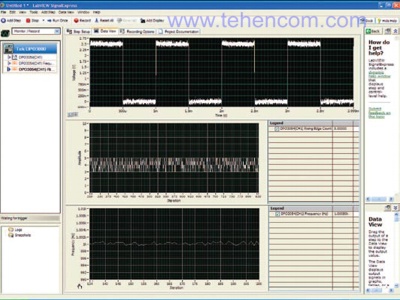
NI LabVIEW SignalExpress Tektronix Edition is a fully interactive acquisition measurement and analysis software optimized for MSO Series oscilloscopes |
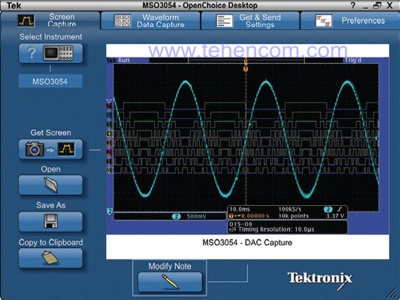
OpenChoice Desktop software makes it easy to connect your oscilloscope to your computer |
The MSO3000 is built for comfort
The MSO3000 Series oscilloscopes are equipped with a large 9-inch (229mm) high-resolution (800 * 480 WVGA) widescreen display that allows you to see the finest signal details.
Vertical deflection controls for each channel make it easy to operate the instrument. You no longer have to use the same set of controls for all four channels.
The USB host port on the front panel allows you to save screenshots, instrument settings, and waveforms to external media. The rear panel has another USB host port and a USB slave port for remote control of the oscilloscope from a computer or for connecting a USB keyboard. The USB slave port can be used for direct printing to a PictBridge compatible printer. A built-in 10/100 Ethernet port provides network connectivity, and a video output allows you to display the oscilloscope screen on an external monitor or projector.
The oscilloscope's small size and convenient design make it easy to move between labs, and its depth of only 147mm saves valuable desktop space.
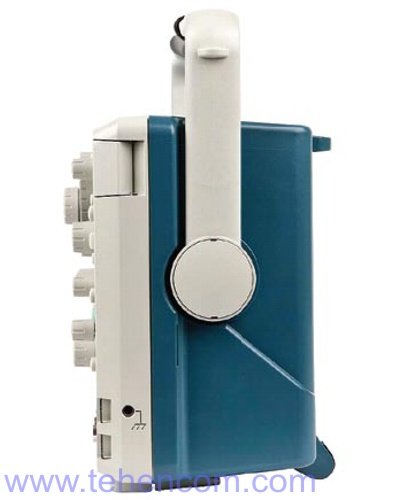
TekVPI® Probe Interface
The TekVPI probe connection interface greatly simplifies the work. TekVPI probes are equipped with status indicators and controls, as well as a probe setup menu button located directly on the block. The TekVPI interface allows direct connection of current probes, eliminating the need for a separate power supply. TekVPI probes can be controlled remotely via USB, GPIB, or Ethernet, allowing for flexible use in automated test and measurement systems.
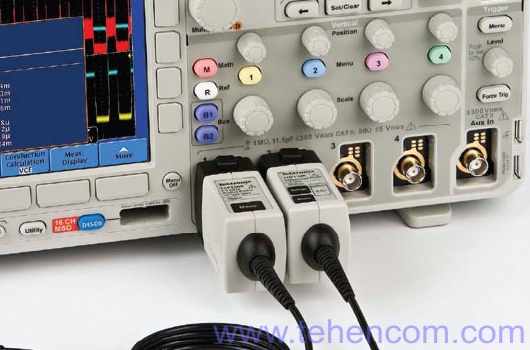
Tektronix MSO3000 and DPO3000 Series Oscilloscope Specifications
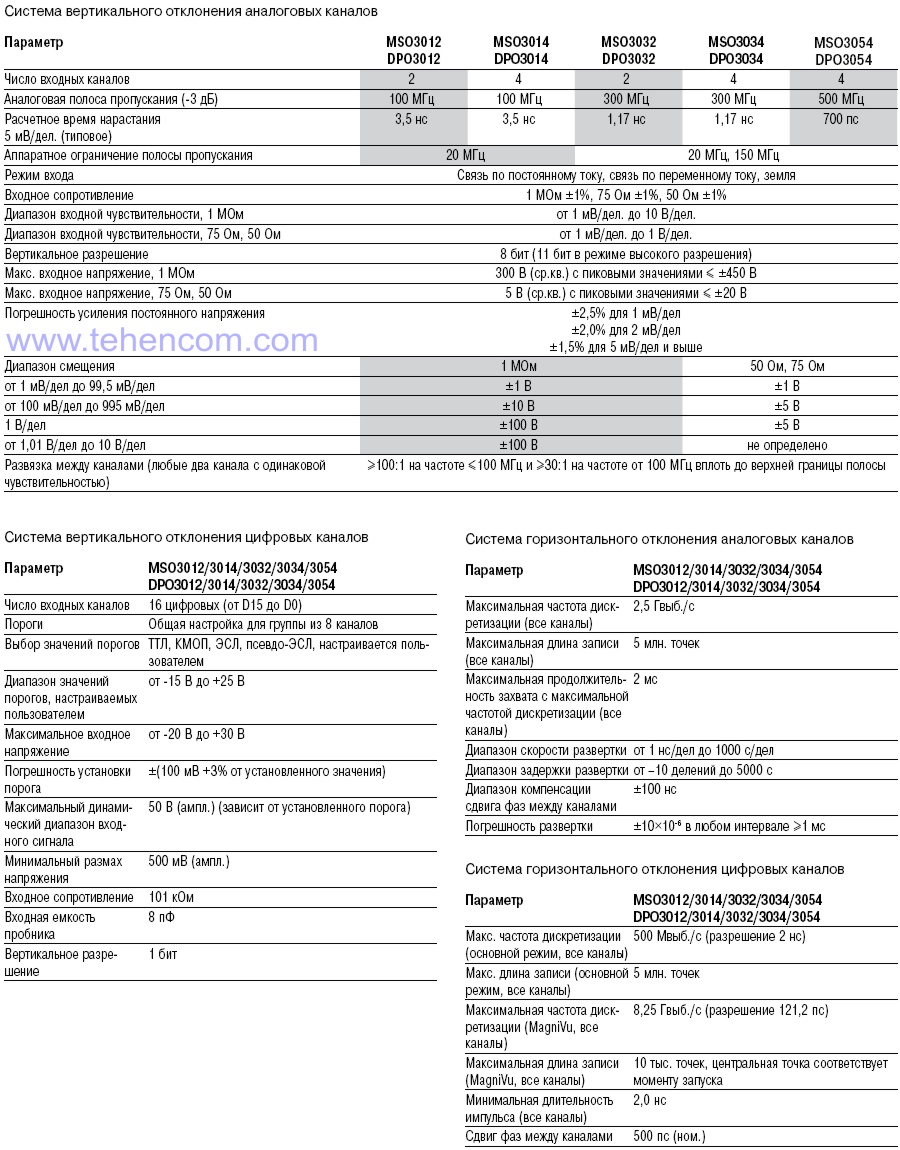
Tektronix MSO3000 and DPO3000 Series Oscilloscope Package Contents
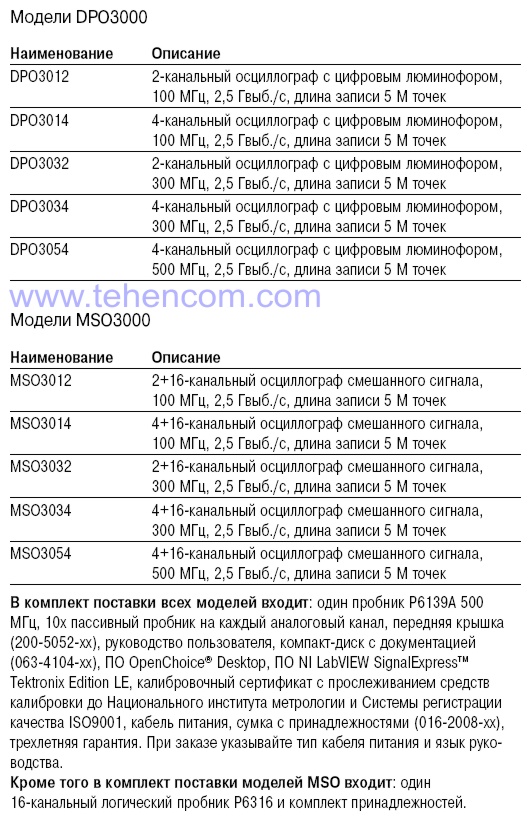
Options and Accessories for Tektronix MSO3000 and DPO3000 Series Oscilloscopes
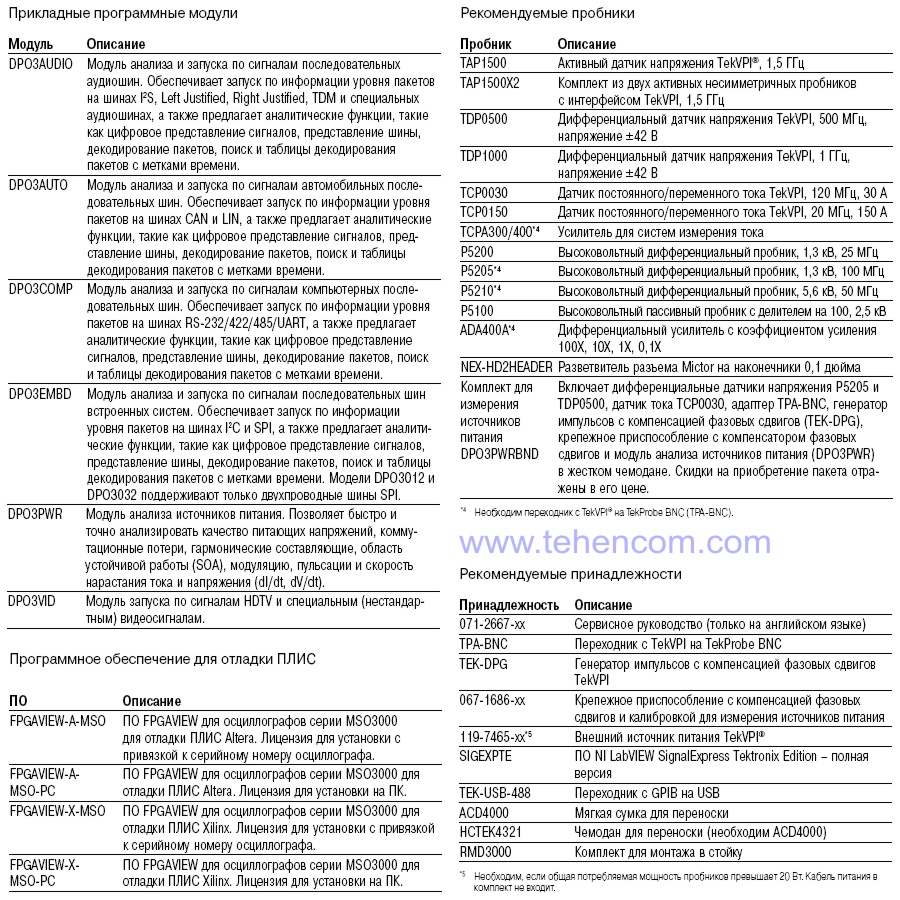
Documentation
Description of Tektronix MSO3000 Series Mixed Signal Oscilloscopes (16 pages; 1.2 MB)
And here you can find our tips and other useful information on this topic:
How to quickly choose an oscilloscope - selection criteria, typical applications and popular models
Comparison of oscilloscopes with a bandwidth of 500 MHz
DPO digital phosphor technology in oscilloscopes - principle of operation, application examples
Passive voltage probes for oscilloscopes
How to buy equipment cheaper - discounts, special prices, demo and used devices
To simplify the process of choosing a digital oscilloscope, you can use our experience and recommendations. We have over 20 years of practical supply experience and can immediately answer many questions about models, options, delivery times, prices and discounts. This will save your time and money. For this it's simple call us or write to us at E-mail and we will be happy to answer your questions.